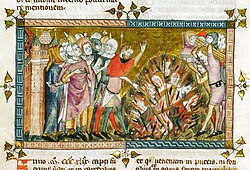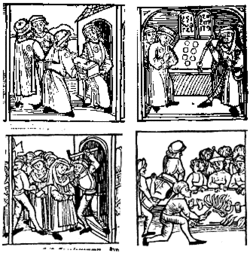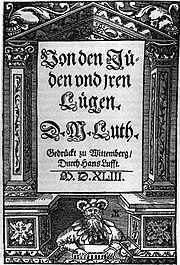Medieval antisemitism
This article has multiple issues. Please help improve it or discuss these issues on the talk page. (Learn how and when to remove these template messages)
|
| Part of a series on |
| Antisemitism |
|---|
 |
|
|
Accusations of deicide
In the
As stated in the Boston College Guide to Passion Plays, "Over the course of time, Christians began to accept... that the Jewish people as a whole were responsible for killing Jesus. According to this interpretation, both the Jews present at Jesus’ death and the Jewish people collectively and for all time, have committed the sin of deicide, or God-killing. For 1900 years of Christian-Jewish history, the charge of deicide (which was originally attributed by Melito of Sardis) has led to hatred, violence against and murder of Jews in Europe and America."[3]
This accusation was repudiated by the Catholic Church in 1964 under
Restrictions to marginal occupations
Among socio-economic factors were restrictions by the authorities. Local rulers and church officials closed many professions to the Jews, pushing them into marginal occupations considered socially inferior, such as tax and rent collecting and
The Black Death

The Black Death plague devastated Europe in the mid-14th century, annihilating more than a half of the population, with Jews being made scapegoats. Rumors spread that they caused the disease by deliberately poisoning wells. Hundreds of Jewish communities were destroyed by violence, in particular in the Iberian peninsula and in the Germanic Empire. In Provence, 40 Jews were burnt in Toulon as early as April 1348.[6] "Never mind that Jews were not immune from the ravages of the plague ; they were tortured until they confessed to crimes that they could not possibly have committed.
"The large and significant Jewish communities in such cities as Nuremberg, Frankfurt, and Mainz were wiped out at this time."(1406)[7] In one such case, a man named Agimet was ... coerced to say that Rabbi Peyret of Chambéry (near Geneva) had ordered him to poison the wells in Venice, Toulouse, and elsewhere. In the aftermath of Agimet's "confession", the Jews of Strasbourg were burned alive on 14 February 1349.[8][9]
Although the Pope Clement VI tried to protect them by the 6 July 1348 papal bull and another 1348 bull, several months later, 900 Jews were burnt in Strasbourg, where the plague hadn't yet affected the city.[6] Clement VI condemned the violence and said those who blamed the plague on the Jews (among whom were the flagellants) had been "seduced by that liar, the Devil."[10]
Demonization of the Jews
From around the 12th century through the 19th there were Christians who believed that some (or all) Jews possessed magical powers; some believed that they had gained these magical powers from making a deal with the devil.
Blood libels
On many occasions, Jews were accused of a blood libel, the supposed drinking of blood of Christian children in mockery of the Christian Eucharist. According to the authors of these blood libels, the 'procedure' for the alleged sacrifice was something like this: a child who had not yet reached puberty was kidnapped and taken to a hidden place. The child would be tortured by Jews, and a crowd would gather at the place of execution (in some accounts the synagogue itself) and engage in a mock tribunal to try the child. The child would be presented to the tribunal naked and tied and eventually be condemned to death. In the end, the child would be crowned with thorns and tied or nailed to a wooden cross. The cross would be raised, and the blood dripping from the child's wounds would be caught in bowls or glasses and then drunk. Finally, the child would be killed with a thrust through the heart from a spear, sword, or dagger. Its dead body would be removed from the cross and concealed or disposed of, but in some instances rituals of black magic would be performed on it.[citation needed]

The story of
During the Middle Ages blood libels were directed against Jews in many parts of Europe. The believers of these accusations reasoned that the Jews, having crucified Jesus, continued to thirst for pure and innocent blood and satisfied their thirst at the expense of innocent Christian children. Following this logic, such charges were typically made in Spring around the time of Passover, which approximately coincides with the time of Jesus' death.[12]
The story of Little Saint Hugh of Lincoln (d. 1255) said that after the boy was dead, his body was removed from the cross and laid on a table. His belly was cut open and his entrails were removed for some occult purpose, such as a divination ritual. The stories of Jews committing blood libel were so widespread that the story of Little Saint Hugh of Lincoln was even used as a source for "The Prioress's Tale," one of the tales included in Geoffrey Chaucer's The Canterbury Tales.
Prior to the late 16th century, the
Association with misery
In Medieval England, Jews were often associated with feelings of misery, dismay, and sadness. According to Thomas Coryate, "to look like a Jew" meant to look disconnected from oneself. This stereotype pervaded all aspects of life, with David Nirenberg noting that Elizabethan cookbooks emphasised Jewish misery.[16]
Host desecration
Disabilities and restrictions

Jews were subject to a wide range of legal disabilities and restrictions throughout the Middle Ages, some of which lasted until the end of the 19th century. Jews were excluded from many trades, the occupations varying with place and time, and determined by the influence of various non-Jewish competing interests. Often Jews were barred from all occupations but money-lending and peddling, with even these at times forbidden. The number of Jews permitted to reside in different places was limited; they were concentrated in ghettos[17] and were not allowed to own land; they were subject to discriminatory taxes on entering cities or districts other than their own, were forced to swear special Jewish Oaths, and suffered a variety of other measures, including restrictions on dress.[1]
Clothing
The
The Crusades

The mobs accompanying the
In the
Expulsions from England, France, Germany, Spain and Portugal

In the
The practice of expelling the Jews accompanied by confiscation of their property, followed by temporary readmissions for
To finance his war to conquer Wales, Edward I of England taxed the Jewish moneylenders. When the Jews could no longer pay, they were accused of disloyalty. Already restricted to a limited number of occupations, the Jews saw Edward abolish their "privilege" to lend money, choke their movements and activities and were forced to wear a yellow patch. The heads of Jewish households were then arrested, over 300 of them taken to the Tower of London and executed, while others killed in their homes. The complete banishment of all Jews from the country in 1290 led to thousands killed and drowned while fleeing and the absence of Jews from England for three and a half centuries, until 1655, when Oliver Cromwell reversed the policy.
In 1492,
.The
Anti-Judaism and the Reformation

Medieval antisemitic art

During the Middle Ages, much art was created by Christians that depicted Jews in a fictional or stereotypical manner; the great majority of narrative religious
Jews as enemies of Christians
Medieval Christians believed in the idea of Jewish "stubbornness", which correlated to many characteristics of the Jewish people. Specifically, Jews did not believe that Christ was the Messiah, a savior. This idea contributed to the stereotype that Jews were stubborn but also extended further in that the Jews dismissed Christ so far that they decided to murder him by nailing him to a cross. Jews were, therefore, marked as the "enemies of Christians" and "Christ-killers."[27]
The notion behind Jews as Christ-killers was one of the main inspirations behind antisemitic portrayals of Jews in Christian art. For example, in one piece, a Jew is placed in between the pages of a Bible[clarify], while sacrificing a lamb with a knife. The lamb is meant to represent Christ, which serves to reveal how Christ died at the hands of the Jewish people.[citation needed]
Jews as devil-like
Further, according to Medieval Christians, anyone who did not agree with their ideas of faith, including the Jewish people, were automatically assumed to be friendly with the devil and simultaneously condemned to hell. Therefore, in many portrayals of Christian art, Jews are made out to resemble demons or interact with the devil. This is meant to not only portray Jews as ugly, evil, and grotesque but also to establish that demons and Jews are innately similar. Jews would also be placed in front of hell to further showcase that they are damned.[27]
Stereotypical Jewish appearances
By the twelfth century, the concept of a "stereotypical Jew" was widely known. A stereotypical Jew was usually a male with a heavy beard, a hat, and a large, crooked nose, all of which were significant identifiers for someone who was Jewish. These notions were portrayed in medieval art, which ultimately ensured that a Jew could easily be identified. The idea behind a stereotypical Jew was to primarily portray a Jew as an ugly creature which is to be avoided and feared.[27]
See also
- Antisemitism
- Geography of antisemitism
- History of antisemitism
- Antisemitism in Europe
- Antisemitism in Christianity
- Christianity and Judaism
- History of the Jews in Europe
- Antisemitism in the Arab world
- Antisemitism in Islam
- History of the Jews under Muslim rule
- Islamic–Jewish relations
- Relations between Nazi Germany and the Arab world
- Jacob Barnet affair
- Jewish history
- History of the Jews in the Middle Ages
- Relations between Eastern Orthodoxy and Judaism
- Catholic Church and Judaism
- Religious antisemitism
References
- ^ a b c d e Johannes, Fried (2015) p. 287-289 The Middle Ages. Cambridge, Massachusetts: Harvard University Press.
- ^ Anti-Semitism In Medieval Europe Encyclopedia Britannica
- ^ Paley, Susan and Koesters, Adrian Gibbons, eds. "A Viewer's Guide to Contemporary Passion Plays" Archived March 1, 2011, at the Wayback Machine, accessed March 12, 2006.
- . Retrieved 2 November 2022.
- ^ Religious Discrimination, Berkman Center - Harvard Law School [dead link]
- ^ a b See Stéphane Barry and Norbert Gualde, La plus grande épidémie de l'histoire ("The greatest epidemics in history"), in L'Histoire magazine, n°310, June 2006, p.47 (in French)
- ^ Johannes, Fried (2015) p. 421. The Middle Ages. Cambridge, Massachusetts: Harvard University Press.
- ISBN 0-06-063834-6
- ^ Johannes, Fried (2015) p. 420. The Middle Ages. Cambridge, Massachusetts: Harvard University Press.
- ISBN 978-0-553-34899-6.
- ^ Bennett, Gillian (2005), "Towards a revaluation of the legend of 'Saint' William of Norwich and its place in the blood libel legend". Folklore, 116(2), pp 119-21.
- ISBN 0-674-39731-2(paper).
- ^ a b c d Teter, Magda. "The Death of Little Simon and the Trial of Jews in Trent." In Blood Libel: On the Trail of an Antisemitic Myth, 43-88. N.p.: Harvard University Press, 2020. http://www.jstor.org/stable/j.ctvt1sj9x.8.
- ^ "Gregory X: Letter about Jews against the Blood Libel". www.jewishvirtuallibrary.org. Retrieved 2023-10-26.
- ISBN 978-1-60606-571-6.
- ^ Nirenberg, David. Anti-Judaism: The Western Tradition.
- ^ Chazan, Robert (2010). Reassessing Jewish Life in Medieval Europe. Cambridge University Press. p. 252.
- ^ Johannes, Fried (2015) p. 160. The Middle Ages. Cambridge, Massachusetts: Harvard University Press.
- ^ Michael Costen, The Cathars and the Albigensian Crusade, p 38
- ISBN 9780706513271.
- ^ "Map of Jewish expulsions and resettlement areas in Europe". Florida Center for Instructional Technology, College of Education, University of South Florida. A Teacher's Guide to the Holocaust. Retrieved 24 December 2012.
- ISBN 0948462469
- ISBN 978-0-393-34791-3
- ISBN 5-551-76858-9
- ^ Luther, Martin. D. Martin Luthers Werke: kritische Gesamtausgabe, Weimar: Hermann Böhlaus Nachfolger, 1920, Vol. 51, p. 195.
- ISBN 978-90-04-39016-4.
- ^ a b c d Strickland, Debra Higgs (2003). Saracens, Demons, and Jews: making monsters in Medieval art. Princeton, N.J.: Princeton University Press.
- ^ Pontius Pilate, anti-Semitism, and the Passion in medieval art. 2009-12-01.
- ^ OCLC 923533086.
- ^ From Notre Dame to Prague, Europe’s anti-Semitism is literally carved in stone Jewish Telegraphic Agency, March 20, 2015
